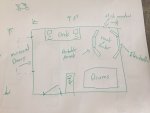I'm "rebuilding" my studio in a basement bedroom and wanted some feedback. The room is small (9.5 ft x 8 ft)
Main Use:
- voiceovers for professional instructional videos, webcasts etc
- recording vocals and acoustic guitar
In the pic is the arrangement of the room. I have Vdrums and will be doing all the bass, electric guitar recording through either my GNX4 or direct into my computer with my current Steinberg UR 22 and/or Roland Duo Capture (plan to replace those with the A&H Zed 10 FX eventually) so I won't be micing live amps, unless I get more serious about recording down the road. For now the studio monitors I'm getting will double as my vdrum and guitar amp.
Main question is around acoustic treatment. I watched that awesome video about sound in rooms and am looking at two options:
1) Wall-mounted Flexibooth and portable acoustic panels that would give me a mostly enclosed area to record acoustic guitar and vocals. The appeal with this option is moving the portable ones and shutting the doors to have more space in the room for practicing.
2) put acoustic panels on the walls in the corner and see how it sounds before getting portable panels.
All the recording I've done so far, I've done in my bedroom closet and my clothes have been my acoustic treatment!
Option 1 is more expensive by about $500 but given what I'm planning to do, I'm most curious about whether it's a waste of money getting the Flexibooth and lining the corner walls would be better.

Main Use:
- voiceovers for professional instructional videos, webcasts etc
- recording vocals and acoustic guitar
In the pic is the arrangement of the room. I have Vdrums and will be doing all the bass, electric guitar recording through either my GNX4 or direct into my computer with my current Steinberg UR 22 and/or Roland Duo Capture (plan to replace those with the A&H Zed 10 FX eventually) so I won't be micing live amps, unless I get more serious about recording down the road. For now the studio monitors I'm getting will double as my vdrum and guitar amp.
Main question is around acoustic treatment. I watched that awesome video about sound in rooms and am looking at two options:
1) Wall-mounted Flexibooth and portable acoustic panels that would give me a mostly enclosed area to record acoustic guitar and vocals. The appeal with this option is moving the portable ones and shutting the doors to have more space in the room for practicing.
2) put acoustic panels on the walls in the corner and see how it sounds before getting portable panels.
All the recording I've done so far, I've done in my bedroom closet and my clothes have been my acoustic treatment!
Option 1 is more expensive by about $500 but given what I'm planning to do, I'm most curious about whether it's a waste of money getting the Flexibooth and lining the corner walls would be better.

Last edited:
